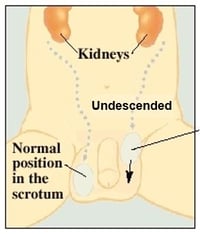Undescended Testis-Orchidopexy
Orchidopexy
What is an undescended testicle (testis)? 
Shortly before birth, a boy's testicles should drop into the scrotum. If a testicle doesn't drop down, it is called undescended testicle (testis). If it has not dropped down by about 6 to 12 months of age, surgery may be needed.
How is it found and treated?
- The newborn exam is the best time to check the testicles. On exam, one or both of the testicles are missing from the scrotum. Often they can be felt in the lower abdomen area.
- If a testicle has not fully moved down by 6 to 12 months, it most likely never will. Waiting longer will not avoid the need for future treatment.
- Age 6 to 12 months is the best time to do surgery. The surgery is called an orchidopexy.
- At times, undescended testicles are not detected at birth. Sometimes, one or both testicles can go back up (ascend) during childhood. They can still be safely fixed with surgery.
Why is surgery needed?
- As adults, patients with undescended testicles that have not been surgically brought down have a slightly higher rate of infertility and testicular cancer.
- It is important for men to do monthly exams of their testicles starting at puberty. If a testicle is not descended, or surgically brought down, a man will not be able to feel that testicle for lumps or problems.
How is the surgery done?
- Most undescended testicles are in the groin. A small cut is made in the groin. The testicle is then carefully pulled down into the scrotum.
- If the testicle is very high in the belly, two surgeries may be needed to move the testicles to the scrotum.
- Stitches are used to keep the testicle in place in the scrotum. They do not come out.
What happens after surgery?
Diet
The day of his procedure, limit your child’s diet to light foods that will digest easily. The nurse will review this with you before you go home.
Activity
Your child’s allowed activity will vary based on their age. The surgeon will review activity restrictions with you.
Wound
- The surgical side(s) will be closed with stitches (sutures) that will dissolve. They do not have to be removed.
- At first, a firm ridge will develop at the wound site. This will slowly go away over several weeks or months.
- If stool gets on the wound site, you may rinse it off with warm water, even within the first 24 hours. Try not to wipe it directly as it will be very tender and fragile.
- Bruising and a little swelling are common. Swelling, tenderness, redness or drainage that gets worse is not normal. Call us if this happens.
Complications
Complications are rare, but may include:
- Wound infection and bleeding.
- Shrinking (atrophy) of the testicle.
- The testicle moves up again (becomes undescended again). This would mean more surgery.
Follow-up
Your doctor will tell you when to follow-up in the clinic. Most often this is 2 to 4 weeks after the surgery.
Pediatric Urology:
Monday through Friday, 8:00am to 4:30pm - (414) 266-3794
Monday through Friday and weekends, 4:30pm to 8:00 - (414) 266-2000 ask for the Urology Resident on call



